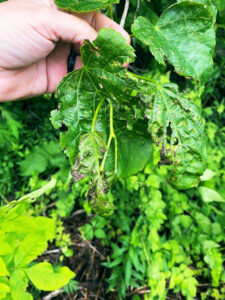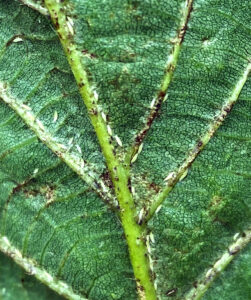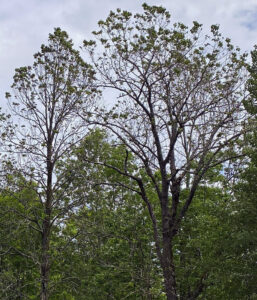By Linda Williams, DNR Forest Health Specialist, Woodruff;
Linda.Williams@wisconsin.gov or 920-360-0665

Basswood leaves show damage due to the feeding of introduced basswood thrips. / Photo Credit: Linda Williams, Wisconsin DNR
For the third consecutive year, damage from introduced basswood thrips (Thrips calcaratus) is significant in some areas of northeast Wisconsin, especially Forest County.
Introduced basswood thrips are tiny, invasive insects that feed inside tree buds in early spring. The feeding causes leaves to deform when they expand, looking like they suffered frost or wind damage.

Tiny white basswood thrips line up along the veins on the underside of leaves, feeding and creating leaf damage. / Photo Credit: Linda Williams, Wisconsin DNR
Trees defoliated by introduced basswood thrips will have tufted foliage and parts of leaves missing. If the damage is severe, trees will attempt to send out a second set of leaves; we see this in many areas. Consecutive years of severe damage can weaken or kill a tree. If the tree survives, recovery can take many years, and they may still die from secondary issues such as Armillaria root rot.
Moderate to severe thrips damage was first observed on basswood trees in Wisconsin in 1980, but the damage was incorrectly attributed to our native thrips, which do not cause noticeable issues. Additional research identified the culprit as introduced basswood thrips (Thrips calcaratus).
At first identification, invasive thrips populations were high and caused severe tree damage. However, in the last 20 years, we have seen low population numbers and very little damage. That changed in 2020 when damage from introduced basswood thrips was noted in Forest, Marinette and Oconto counties. In 2021, severe damage was also reported in Rusk and Sawyer counties in northwestern Wisconsin and Florence, Forest, Marinette and Oneida counties in northeastern Wisconsin. In 2022, damage was observed in Forest and Oconto counties and in 2023, defoliation was observed in Oneida, Forest and Marinette counties. So far this year, defoliation has been seen in Oneida, Forest, Marinette, Washburn and Rusk counties.
There is only one generation of thrips per year, so the damage is done by the time defoliation is noticeable. Therefore, pesticides have no impact.
Instead, landowners should minimize stress on damaged stands and keep trees healthy during outbreaks. This will help trees tolerate defoliation and retain the energy to send out a second set of leaves.

Introduced basswood thrips feed in expanding buds and create significant damage to basswood leaves once those leaves emerge. / Photo Credit: Linda Williams, Wisconsin DNR
